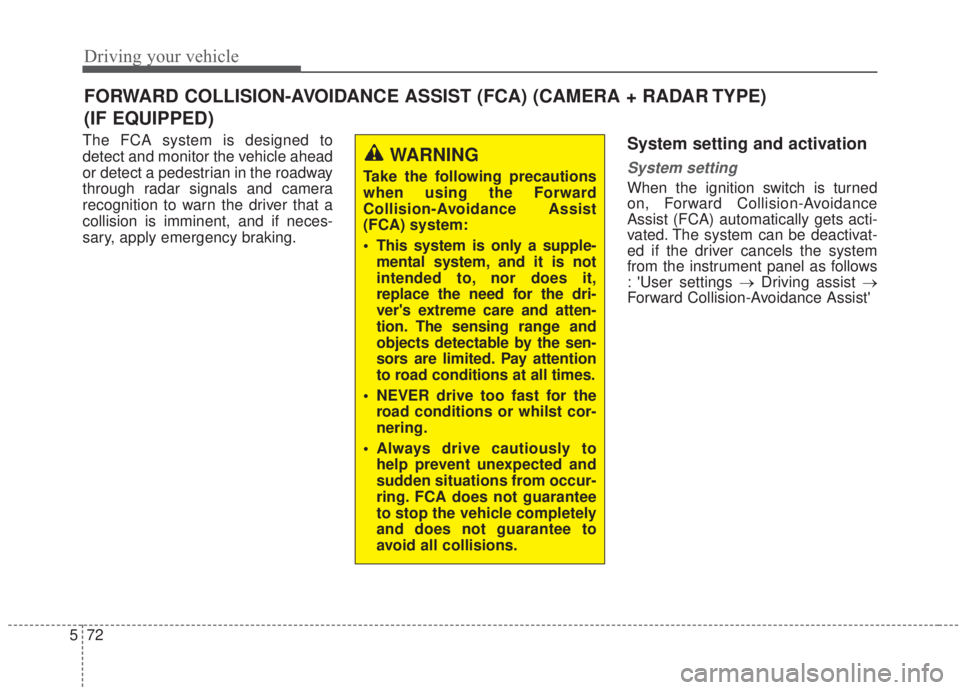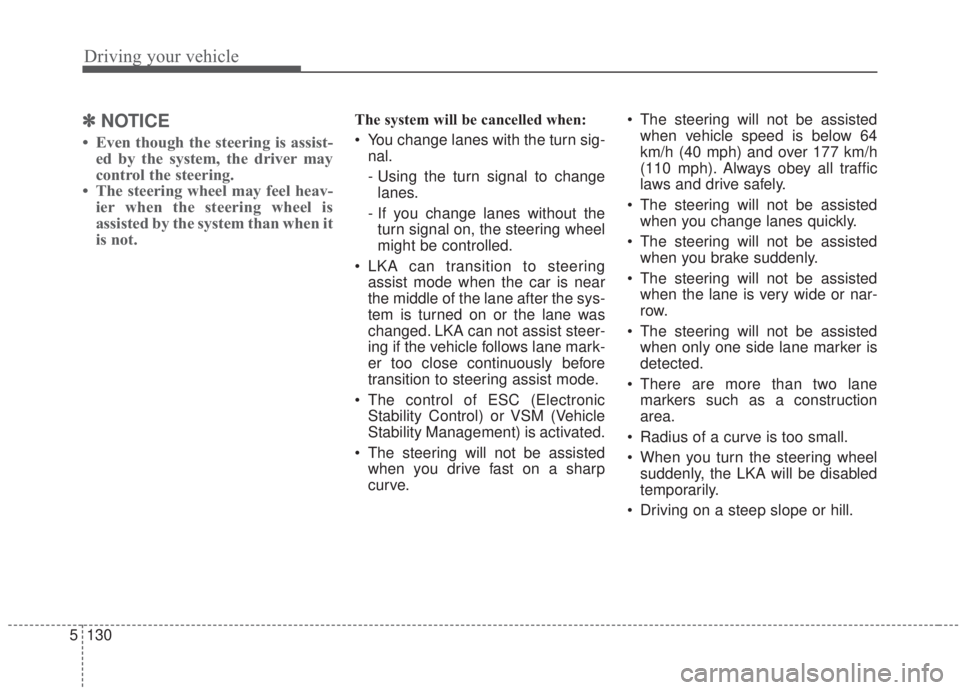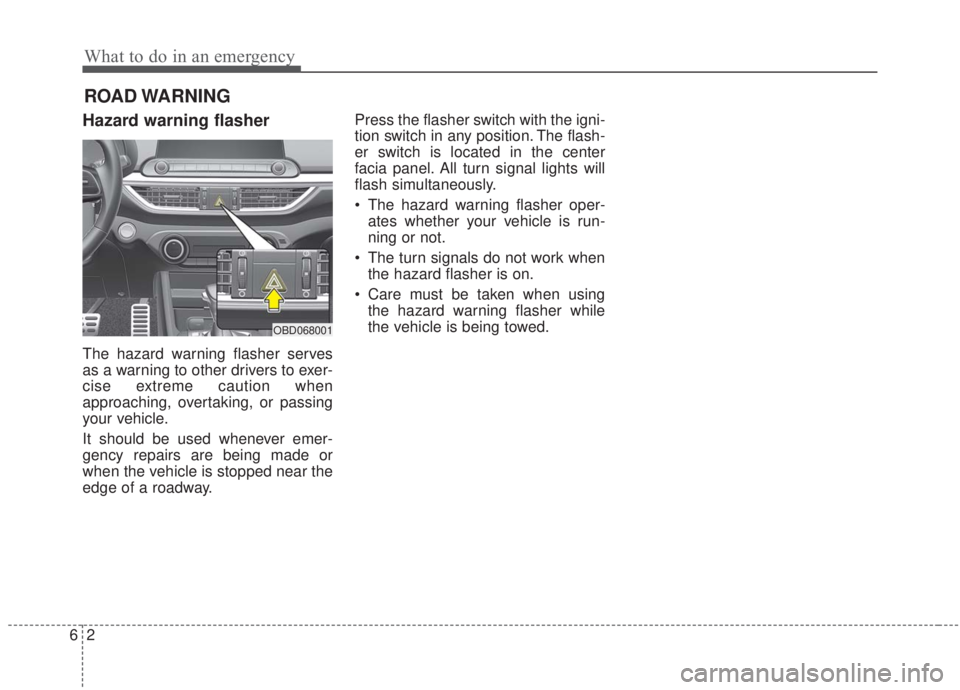2020 KIA FORTE turn signal
[x] Cancel search: turn signalPage 192 of 568

4107
Features of your vehicle
If an indicator stays on and does not
flash or if it flashes abnormally, one of
the turn signal bulbs may be burned
out and will require replacement.
✽ ✽NOTICE
If an indicator flash is abnormally
quick or slow, a bulb may be burned
out or have a poor electrical connec-
tion in the circuit.
Front fog light (if equipped)
Fog lights are used to provide
improved visibility when visibility is
poor due to fog, rain or snow, etc. The
fog lights will turn on when the fog light
switch (1) is turned to the on position
after the headlights are turned on.
To turn off the fog lights, turn the
switch (1) to the off position.
When in operation, the fog lights
consume large amounts of vehicle
electrical power. Only use the fog
lights when visibility is poor.
OJF045058
Page 318 of 568

Driving your vehicle
72
5
The FCA system is designed to
detect and monitor the vehicle ahead
or detect a pedestrian in the roadway
through radar signals and camera
recognition to warn the driver that a
collision is imminent, and if neces-
sary, apply emergency braking.System setting and activation
System setting
When the ignition switch is turned
on, Forward Collision-Avoidance
Assist (FCA) automatically gets acti-
vated. The system can be deactivat-
ed if the driver cancels the system
from the instrument panel as follows
: 'User settings → Driving assist →
Forward Collision-Avoidance Assist'
FORWARD COLLISION-AVOIDANCE ASSIST (FCA) (CAMERA + RADAR TYPE)
(IF EQUIPPED)
WARNING
Take the following precautions
when using the Forward
Collision-Avoidance Assist
(FCA) system:
This system is only a supple-
mental system, and it is not
intended to, nor does it,
replace the need for the dri-
ver's extreme care and atten-
tion. The sensing range and
objects detectable by the sen-
sors are limited. Pay attention
to road conditions at all times.
NEVER drive too fast for the road conditions or whilst cor-
nering.
Always drive cautiously to help prevent unexpected and
sudden situations from occur-
ring. FCA does not guarantee
to stop the vehicle completely
and does not guarantee to
avoid all collisions.
Page 361 of 568

5115
Driving your vehicle
The Blind-Spot Collision Warning
(BCW) system uses radar sensors in
the rear bumper to monitor and warn
the driver of an approaching vehicle
in the driver's blind spot area.
The system monitors the rear area of
the vehicle and provides information
to the driver with an audible alert and
an indicator on the outside rearview
mirrors.(1) Blind spot area
The BCW range varies relative tovehicle speed. Note that if your
vehicle is traveling much faster
than the vehicles around you, the
warning will not occur. (2) Closing at high speed
The BCW-Closing at high speedfeature will alert you when a vehi-
cle is approaching in an adjacent
lane at a high rate of speed. If the
driver activates the turn signal
when the system detects an
oncoming vehicle, the system
sounds an audible alert. Distance
from an approaching vehicle can
be seen differently according to
the relative speed.
(3) RCCW (Rear Cross-Traffic Collision Warning)
The RCCW feature monitors approaching cross traffic from the
left and right side of the vehicle
when your vehicle is in reverse.
The feature will operate when the
vehicle is moving in reverse
below about 10 km/h (6 mph). If
oncoming cross traffic is detect-
ed, a warning chime will sound.
Distance from an approaching
vehicle can be seen differently
according to the relative speed.
BLIND-SPOT COLLISION WARNING (BCW) (IF EQUIPPED)
WARNING
Always be aware of road con- ditions while driving and be
alert for unexpected situa-
tions even though the BCW
system is operating.
The BCW is not a substitute for proper and safe driving.
Always drive safely and use
caution when changing lanes
or backing up the vehicle. The
BCW may not detect every
object alongside the vehicle.
OBD058079L
Page 364 of 568

Driving your vehicle
118
5
Second stage alert
A warning chime to alert the driver
will activate when:
1. A vehicle has been detected in the
blind spot area by the radar system
(the warning light will illuminate on
the outside rearview mirror, i.e., in
the first stage alert)
AND
2. The turn signal is applied (same side as where the vehicle is being
detected).
When this alert is activated, the
warning light on the outside rearview
mirror will also blink. If you turn off the turn signal indica-
tor, the second stage alert (the warn-
ing chime and the blinking warning
light on the outside rearview mirror)
will be deactivated.
- The second stage alarm can be
activated and deactivated.
To activate the alarm: Go to the User Settings Mode →
Driver Assistance and select
“Blind-Spot Collision Warning” on
the LCD display.
To deactivate the alarm: Go to the User Settings Mode →
Driver Assistance and deselect
“Blind-Spot Collision Warning” on
the LCD display.
Detecting sensor
The sensors are located inside the
rear bumper.
Always keep the rear bumper clean
for the system to work properly.
OJF055215
2nd stage
CAUTION
The warning chime functionhelps alert the driver. Deactivatethis function only when it is nec-essary, and refer to the “UserSettings Mode” section inChapter 4.
OBD058039L
Page 376 of 568

Driving your vehicle
130
5
✽ ✽
NOTICE
• Even though the steering is assist-
ed by the system, the driver may
control the steering.
• The steering wheel may feel heav- ier when the steering wheel is
assisted by the system than when it
is not.
The system will be cancelled when:
You change lanes with the turn sig-
nal.
- Using the turn signal to changelanes.
- If you change lanes without the turn signal on, the steering wheel
might be controlled.
LKA can transition to steering assist mode when the car is near
the middle of the lane after the sys-
tem is turned on or the lane was
changed. LKA can not assist steer-
ing if the vehicle follows lane mark-
er too close continuously before
transition to steering assist mode.
The control of ESC (Electronic Stability Control) or VSM (Vehicle
Stability Management) is activated.
The steering will not be assisted when you drive fast on a sharp
curve. The steering will not be assisted
when vehicle speed is below 64
km/h (40 mph) and over 177 km/h
(110 mph). Always obey all traffic
laws and drive safely.
The steering will not be assisted when you change lanes quickly.
The steering will not be assisted when you brake suddenly.
The steering will not be assisted when the lane is very wide or nar-
row.
The steering will not be assisted when only one side lane marker is
detected.
There are more than two lane markers such as a construction
area.
Radius of a curve is too small.
When you turn the steering wheel suddenly, the LKA will be disabled
temporarily.
Driving on a steep slope or hill.
Page 401 of 568

What to do in an emergency
26
ROAD WARNING
Hazard warning flasher
The hazard warning flasher serves
as a warning to other drivers to exer-
cise extreme caution when
approaching, overtaking, or passing
your vehicle.
It should be used whenever emer-
gency repairs are being made or
when the vehicle is stopped near the
edge of a roadway.Press the flasher switch with the igni-
tion switch in any position. The flash-
er switch is located in the center
facia panel. All turn signal lights will
flash simultaneously.
• The hazard warning flasher oper-
ates whether your vehicle is run-
ning or not.
The turn signals do not work when the hazard flasher is on.
Care must be taken when using the hazard warning flasher while
the vehicle is being towed.
OBD068001
Page 439 of 568

• Radial-ply tires . . . . . . . . . . . . . . . . . . . . . . . . . . . . . . 7-59
• Low aspect ratio tire . . . . . . . . . . . . . . . . . . . . . . . . . . 7-60
Fuses . . . . . . . . . . . . . . . . . . . . . . . . . . . . . . . . . . . . \
7-61
• Inner panel fuse replacement . . . . . . . . . . . . . . . . . . . 7-63
• Engine compartment fuse replacement. . . . . . . . . . . 7-64
• Fuse/relay panel description. . . . . . . . . . . . . . . . . . . . 7-67
Light bulbs . . . . . . . . . . . . . . . . . . . . . . . . . . . . . . . 7-77
• Bulb replacement precaution . . . . . . . . . . . . . . . . . . 7-77
• Light bulb position (Front). . . . . . . . . . . . . . . . . . . . . 7-79
• Light bulb position (Rear) . . . . . . . . . . . . . . . . . . . . . 7-80
• Light bulb position (Side) . . . . . . . . . . . . . . . . . . . . . . 7-81
• Headlamp (Low beam) bulb replacement(Headlamp Type A,B) . . . . . . . . . . . . . . . . . . . . . . . . 7-81
• Headlamp (High beam) bulb replacement (Headlamp Type A,B) . . . . . . . . . . . . . . . . . . . . . . . . 7-83
• Side marker bulb replacement (Headlamp Type A,B) . . . . . . . . . . . . . . . . . . . . . . . . 7-84
• Position lamp / Day time running lamp (LED type) replacement (Headlamp Type B) . . . . . . . . . . . . . . . 7-85
• Headlamp (LED type) replacement (Headlamp Type C) . . . . . . . . . . . . . . . . . . . . . . . . . . 7-85
• Front turn signal lamp bulb replacement . . . . . . . . . 7-85
• Front fog lamp bulb replacement . . . . . . . . . . . . . . . 7-86
• Day time running lamp (Bulb type) replacement . . 7-86
• Side repeater lamp (LED type) bulb replacement . . 7-86 • Side repeater lamp (Bulb type) bulb replacement . . 7-87
• Stop and tail lamp/side marker (Bulb type) bulb
replacement (Rear combination lamp Type A) . . . 7-87
• Tail lamp (inside) (Bulb type) bulb replacement (Rear combination lamp Type A) . . . . . . . . . . . . . . 7-88
• Stop and tail lamp (LED type) bulb replacement (Rear combination lamp Type B) . . . . . . . . . . . . . . 7-89
• Side marker (LED type) bulb replacement (Rear combination lamp Type B) . . . . . . . . . . . . . . 7-90
• Rear turn signal lamp bulb replacement . . . . . . . . . 7-90
• Back up lamp bulb replacement . . . . . . . . . . . . . . . . 7-90
• High mounted stop lamp (LED type) bulb replacement . . . . . . . . . . . . . . . . . . . . . . . . . . . . . . . . 7-91
• High mounted stop lamp (bulb type) bulb replacement . . . . . . . . . . . . . . . . . . . . . . . . . . . . . . . . 7-91
• License plate lamp bulb replacement . . . . . . . . . . . . 7-92
• Map lamp (Bulb type) bulb replacement . . . . . . . . . 7-92
• Map lamp (LED type) bulb replacement . . . . . . . . . 7-93
• Room lamp (Bulb type) bulb replacement . . . . . . . . 7-93
• Room lamp (LED type) bulb replacement . . . . . . . . 7-94
• Vanity mirror lamp bulb replacement . . . . . . . . . . . 7-94
• Glove box lamp replacement . . . . . . . . . . . . . . . . . . . 7-95
• Trunk room lamp replacement . . . . . . . . . . . . . . . . . 7-96
7
Page 446 of 568

79
Maintenance
Check the parking brake.
Check for fluid leaks under yourvehicle (water dripping from the air
conditioning system during or after
use is normal).
At least monthly:
Check the coolant level in theengine coolant reservoir.
Check the operation of all exterior lights, including the stoplights, turn
signals and hazard warning flash-
ers.
Check the inflation pressures of all tires including the spare.
At least twice a year
(i.e., every Spring and Fall) :
Check the radiator, heater and air conditioning hoses for leaks or
damage.
Check the windshield washer spray and wiper operation. Clean
the wiper blades with a clean cloth
dampened with washer fluid.
Check the headlight alignment.
Check the muffler, exhaust pipes, shields and clamps.
Check the lap/shoulder belts for wear and function.
Check for worn tires and loose wheel lug nuts.
At least once a year :
Clean the body and door drainholes.
Lubricate the door hinges and check the hood hinges.
Lubricate the door and hood locks and latches.
Lubricate the door rubber weather- strips.
Check the air conditioning system.
Inspect and lubricate dual clutch transmission/intelligent variable
transmission linkage and controls.
Clean the battery and terminals.
Check the brake fluid level.